July 2021 marked what would have been the 100th birthday of Karl H. Bröhan, initiator of the collection that initiated Berlin's Bröhan Museum; a centenary marked by the museum with the exhibition Bröhan Total!, a, as the title implies, comprehensive presentation of that collection.
A presentation of the Total! Bröhan collection, an intensive examination, and study, of the Total! Bröhan collection by the Bröhan Museum which, indirectly and directly, led the Bröhan Museum to undertake, if one so will, a gender audit of their Total! collection; an audit which came to the conclusion that from the ca. 20,000 objects therein just some 1,500 were by females creatives, or ca. 7.5%. And from the ca. 1100 creatives represented in that collection just some 99 were female, ca. 10%; thus more than the 7.5% of the objects indicating a greater average object per head ratio for male creatives than females.
Numbers which led to questions, not least questions of why, and subsequently led the Bröhan Museum Berlin to the exhibition Regard! Art and Design by Women 1880–1940.
An exhibition which presents works by all 99 female creatives represented in the Bröhan Museum collection, and allows space for your own reflections on the numbers, the biographies, the (hi)story of design, museum collections, and for all the myriad whys. The myriad whys, then and now.......
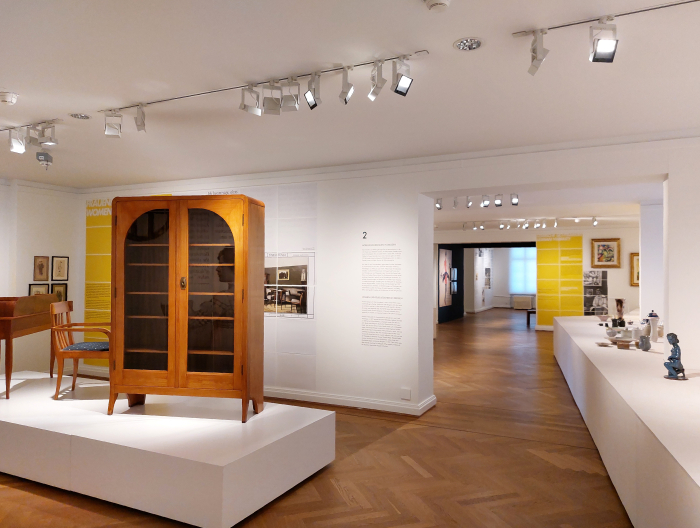
As Berlin's State Museum for Art Nouveau, Art Deco and Functionalism the "1880–1940" of the exhibition's title is anything but random, rather is dictated by the museum's area of expertise; while the words "Art" and "Design" help elucidate that that time span represents that period when art and design began to separate, dissociate, when, if one so will, design began to stop being a synonym of art, the function of objects began to stop being the form alone, and design began to emerge and to establish itself as an autonomous genre, independent of, but inter-related with, art. And independent of, but inter-related with, the "Craft" which isn't in the exhibition title but, arguably, could, should, be. Alone the word "Regard!" causes questions, is initially bothersome, hard to explain. And the word "Women". The presence of both however becomes much clearer when viewing Regard! Art and Design by Women 1880–1940.
As an exhibition Regard! takes you on an a chronological and material journey through the 6 decades of its title in 8 chapters. 8 chapters starting from the Berlin Secession of the late 19th century and moving on over the Wiener Werkstätte and the fledgling Dresden furniture industry of the early 20th century and further on to the Weimar Republic, that period that was so important and influential for the development of creativity of all genres in Europe. And which ended in such catastrophe. The chronology being expanded and focussed by chapters exploring ceramics, textiles and metal, before ending with the mid-1920s Neue Frankfurt urban planning, architecture and design programme, a Neue Frankfurt presentation dominated by Margarete Schütte-Lihotzky's legendary, and distortive, kitchen design.1
8 chapters which introduce the viewer to the biographies of selected protagonists, including, and amongst many, many others the sculptor Chana Orloff, born in Starokostiantyniv, Ukraine, and who twice had to flee on account of her Jewish faith, first fleeing Ukraine from the Russians and subsequently fleeing France from the Germans; the furniture designers Gertrud Kleinhempel and Margarete Junge who contributed so importantly, and elegantly, to the development, the rise, of furniture design in the early decades of the 20th century before furniture became a male dominion and they both found themselves increasingly limited, restricted, to and by the more ⚠️ 🚨 ⚠️ 🚨 ¡¡¡ SARCASM ALARM !!! ⚠️ 🚨 ⚠️ 🚨 appropriately feminine disciplines of textiles and clothing; the artist and political activist Julie Wolfthorn who amongst other causes, campaigned for the abolition of Germany's abortion prohibiting §218 of the Federal Criminal Code, an article, and abortion ban, which still stands, at least on paper if only rarely fully enforced, but always intimidating and limiting. Or Margarete Schütte-Lihotzky who greets you in the Neue Frankfurt presentation with the determined words "I am not a kitchen!" as your gaze wanders over that kitchen which dominates the Neue Frankfurt discussion, and which so popularly, and distortively, defines Margarete Schütte-Lihotzky.
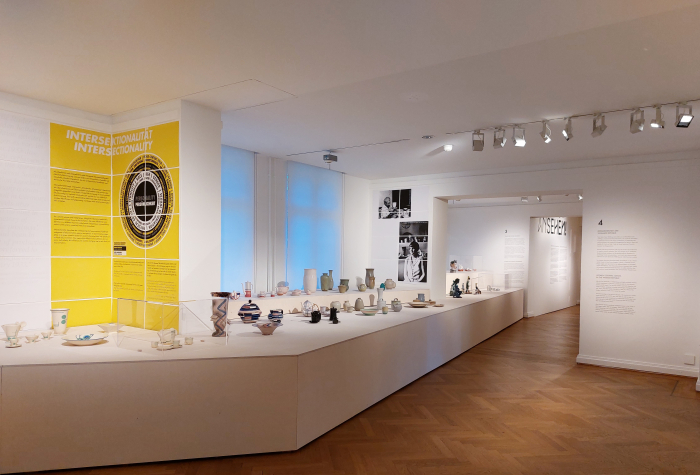
8 chapters which go beyond the protagonists, their works and the wider creativity of the time span, to discuss some of the political, social and cultural structures, conventions and realities of that time span. A period, lest we forget, that not only saw changes in the nature of art and design, but also in society, including in context of women and society, was a period of ever greater emancipation, enfranchising and empowerment of women. Or at least relative emancipation, enfranchising and empowerment of women. And political, social and cultural structures, conventions and realities that not only influenced, defined, the opportunities and careers of the 99 represented creatives, but which, in many cases, play a role in their relative anonymity today. Structures, conventions and realities such as, for example, attitudes towards, and support for, working mothers, not least single working mothers; gender (in)equality in terms of, for example, pay, career opportunities, or the consequences of war and displacement; the contribution and importance of self-organisation and the construction of professional/political/social female networks; or attitudes to/practical reality of the roles and functions of males and females in running a "shared" household, the latter discussed in the Neue Frankfurt presentation, where Margarete Schütte-Lihotzky asseverates that she had never cooked before she designed her rationally optimised, functionally defined, conceptually grounded, space-saving, and distortive, kitchen. Yet the fact it was a kitchen designed by a woman was not only accepted, and celebrated, and marketed, in the 1920s, but remains largely unquestioned today: of course a woman designed a kitchen, ran and runs the popular refrain, women use kitchens. Unless it's a professional restaurant kitchen, then a man uses it. Obviously.
And 8 chapters which in their mix of the biographical, the creative and the contextual not only allow for differentiated insights into the realities of and for female creatives at the turn of the 19th/20th centuries, differentiated insights into the problems faced by female creatives at the turn of the 19th/20th centuries, but through a highlighting of and discussions on the ongoing relevance of many of the political, social and cultural structures, conventions and realities in context of the opportunities, and careers, of contemporary female creatives, build a very nice bridge between the early 20th century and the early 21st century; a bridge which enables you to, allows you to, forces you to, demands you reflect on the contemporary situation of contemporary female creatives, and to question how will design by women in the years 1980–2040 be understood in 2122.2 Assuming, that is, we all make it that far.
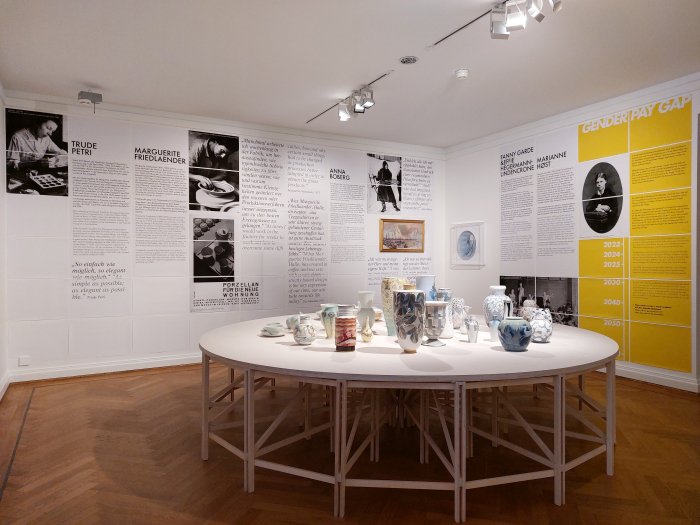
Now there will be those who argue that through highlighting only female creatives one places those creatives in a gender ghetto, makes their femaleness the key factor in their work, makes being a female artist or designer something astoundingly extraordinary, worthy of displaying, ⚠️ 🚨 ⚠️ 🚨 ¡¡¡ SARCASM ALARM !!! ⚠️ 🚨 ⚠️ 🚨 "ooooh look, it's by a female!!! And it's quite good!!!". And creating such a gehtto is always possible. If that is or isn't the case depends on how the respective exhibition is set up, and Regard! is very much an exhibition focussed on the contexts, the creatives are at the heart of the concept, but primarily as conduits for wider reflections on the political, social and cultural structures, conventions and realities, in which design careers existed and exist. Regard! is very much focussed on the fact, the popularly under, non, discussed fact, that the contexts then and now are eminently comparable. And thereby demanding that discussion.
And there will be those who who further argue that no exhibtion should ever distinguish on lines of race, religion, gender, whatever, but place works interesting and informative and meaningful in context of the theme and/or curatorial position alongside one another. And you'd be right.
But in the recent past that only very rarely happened. In the recent past (white European) men were primarily and predominately exhibited, certainly in context of design. Whereby the Bröhan Museum is an excellent case in point: as previously discussed, their 2019 exhibition From Arts and Crafts to the Bauhaus. Art and Design – A New Unity reduced the contribution of females to Marianne Brandt, Marguerite Friedlaender, Lucia Moholy and Ida Kerkovius, four creatives at the Bauhaus end of that long narrative. And of whom only Marianne Brandt and Marguerite Friedlaender are represented in the Bröhan Museum collection. Yet as Regard! ably demonstrates the Bröhan Museum had a further 97 female creatives in their collection, including numerous at the Arts and Crafts end of that long narrative, who could have been part of From Arts and Crafts to the Bauhaus.3 Who were part of the original journey from Arts and Crafts to the Bauhaus. Until that became a near exclusively male journey. As documented for posterity in the Arts and Crafts to the Bauhaus catalogue. Not that the Bröhan Museum is alone, and certainly when one looks at the number of major monographic exhibitions devoted to female creatives in the recent past as compared to the number devoted to male creatives, one gets very much the impression of design (hi)story as a design (his)tory. Or at best, a (hi)story featuring very occasional women who found success in conjunction with a man.
That is slowly changing, not least because ever more design museums, as with the Bröhan Museum, are starting to reflect critically on not only their collections, but their exhibition practice. However, the damage done by decades past can't just be instantly repaired nor should we pretend it doesn't exist and gaily enjoy major monographic exhibitions of those few females whose names are popularly known and pretend that all is thereby right with the world. It's not. Rather, those female creatives who have slipped into an unjust anonymity need to be allowed the opportunity to retake their place on design's helix, need to, and to paraphrase Vera Sacchetti and Matylda Krzykowski, be added to the cake of contemporary culture, in order that discussions on design (hi)story, discussions on design, can be undertaken in a more probable place than they currently are, and that requires, we'll argue, as an important step, general exhibitions such as, for example, Female Traces at the Museum of Furniture Studies Stockholm, Spot On: Women Designers in the Collection at the Vitra Design Museum Schaudepot or Regard! in which museums enable reflection, and a public discussion, on their own collection by way of stimulating wider research and popular public appreciation. And that not just in terms of gender, but universally.
And in that context, what does Regard! tell us?
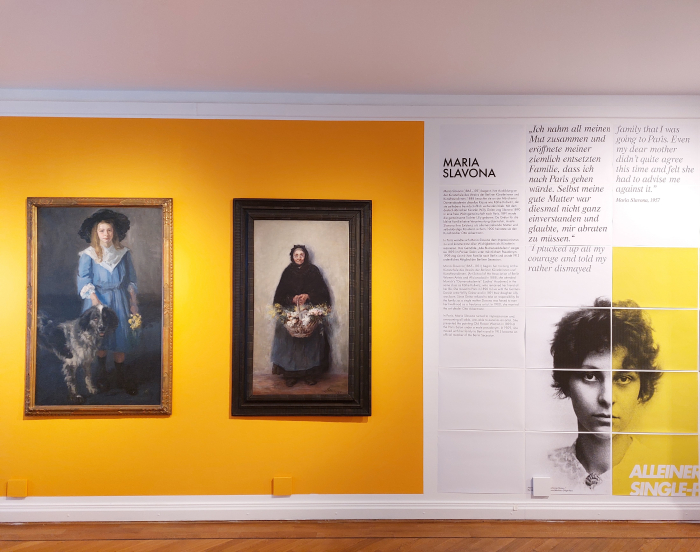
Regard! tells us that the Bröhan Museum Berlin's collection, certainly as far as it concerns female creatives, is very Germano-centric; while there are various and varied Swedish, Danish, French, etc creatives to be found amongst the 99 the vast majority are German or Austrian. Which, arguably, shouldn't surprise us, the museum's collection is based on a collection largely organised from West Berlin by a German.4 However, through its dominance by Germanic creatives, a dominance ably supported by Regard!'s narrative which sees the (hi)story of art and design in the years 1880-1940 move from Berlin over Vienna and Dresden to the Weimar Republic5, it does tend to confirm that that period under consideration was one primarily defined by German/Austrian creatives, with a few inputs from elsewhere. But was it? Were there genuinely many more German/Austrian creatives active in Germany/Austria than from and active elsewhere in the years 1880-1940? Or is it an oversimplification? And the Bröhan Museum's collection a reflection of a regional bias?
Regard! tells us that the Bröhan Museum Berlin's collection, certainly as far as it concerns female creatives, is very ceramic centric, or at least appears to be by the presentation in Regard!. Which, arguably, shouldn't surprise us, throughout the period under discussion ceramics represented one of the easiest paths for females seeking a career as a designer, one of the paths of least resistance, less strewn with obstacles. ⚠️ 🚨 ⚠️ 🚨 ¡¡¡ SARCASM ALARM !!! ⚠️ 🚨 ⚠️ 🚨 Before in our own age that path became one of textiles and colour. But for all the predominance of ceramics may make sense, is Regard! reflective of the percentage of female creatives in the years 1880-1940 who primarily busied themselves with ceramics? Or is it an oversimplification? And the Bröhan Museum's collection a self-fulfilling reinforcement of a popular prejudice?
Regard! tells us that the Bröhan Museum Berlin's collection, the collection of Berlin's State Museum for Art Nouveau, Art Deco and Functionalism, possesses no works by Lilly Reich. Which, arguably, shouldn't surprise us. A Lilly Reich who was born in Berlin in 1885, trained in Berlin in the early 1900s, developed as a young creative in Berlin in the years leading up to, and during, the Great War, spent the greater part of her inter-War career based in Berlin, died in Berlin in 1947. Isn't in the collection of Berlin's State Museum for Art Nouveau, Art Deco and Functionalism. Which, no, isn't us being petty. Or mean. Or dogmatically pro Lilly Reich. It's not a criticism, it's simply an observation. There is no law that says the Bröhan Museum has to have works by Lilly Reich, no moral, ethical, professional compulsion for the Bröhan Museum to have works by Lilly Reich.
And far from being a complaint, the fact the Bröhan Museum don't have any works by Lilly Reich, or works by, for example, and staying very much in the second half of Regard!'s time span, Gunta Stölzl, Eileen Gray, Aino Aalto, or Charlotte Perriand, or Lucia Moholy, or Ida Kerkovius, coupled to the preponderances of ceramics in Regard! and of German/Austrian creatives in the collection, is informative, interesting and important, for it underscores the inherent potential deficiencies in any museum's collection6, reinforces that while museum collections are one of the more important repositories for helping us understand the past, understanding the path we've all taken to today, they are repositories that, inevitably, present but a partial picture, are but a snapshot of the past, are repositories with gaps; and thus repositories that should always be approached questioningly as a route to possible answers not as the reliable suppliers of definitive answers they've often been confused for in the past. An appreciation that helps elucidate that a meaningful route to those possible answers may be less through the collection, and more through the gaps.
Which leads one on very naturally to an appreciation that while gaps in a collection can be useful, it would be preferable not to have them, and ideal if, going forward, we could avoid them.
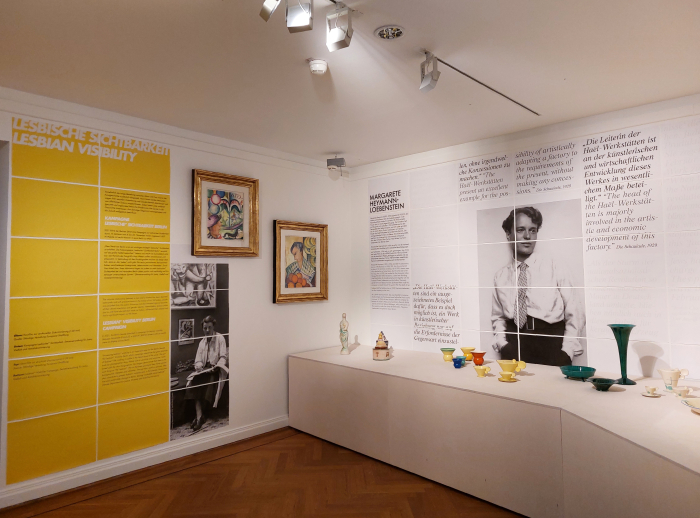
The longer we strolled round Regard! the more the thought settled within us that amongst the many and varied, and valid, political, social and cultural structures, conventions and realities discussed by the exhibition, and which in their varying ways have and do impacted, impact, on and influenced, influence, the careers but of female creatives, one was very, very noticeable in its absence: how museums collected art and design, for all design, in the past and how art and design, contemporary and historic, is collected today. Which is, arguably, a central theme of Regard!, Regard! is after all the presentation of the questioning of a collection. And as a gap in Regard! a meaningful route to approach Regard!
Karl H. Bröhan, as far as we understand, didn't start seriously collecting in a targeted manner until the 1960s, by which point a lot of those female creatives who had been active between 1880 and 1940 would have slipped into an anonymity. Not least on account of the War and the lead up to the War. On the one hand things got destroyed, for example, the majority of Lilly Reich's archive being destroyed as a consequence of Allied bombings of Berlin in 1943, and on the other hand not only were careers disrupted in the immediate pre-War years but not all creatives were, for want of a better word, rediscovered post-War. Amongst the political, social and cultural structures, conventions and realities that are discussed in Regard! is Intersectionality, the position that the various forms of discrimination human society in our infinite wisdom have developed, act cumulatively on those exposed to more than one form of discrimination, and thus, as Regard! very satisfyingly discuses, because in the years under survey being a woman was often a source of discrimination over and above, for example, your family's social status, your religion, your marital status, your political affiliations, your sexuality, your nationality, etc, women were affected to a greater extent by the disruptions of the rise of Fascism and the War than men. And then in the immediate post-War decades, we'd argue, as, for example, we did from Against Invisibility – Women Designers at the Deutsche Werkstätten Hellerau 1898 to 1938 at the Kunstgewerbemuseum Dresden, female creatives were only rarely researched and actively re-discovered, arguably, because the more visible and better recorded men were given priority and primacy. Eileen Gray, for example, remained largely unknown until being rediscovered more by chance than conscientious research in the 1970s, and, as previously noted, in 1947 the MoMa New York and Mies van der Rohe effectively wrote Lilly Reich out of architecture and design (hi)story, their utter negation of her work making any research into her an apparently futile act, and defining understandings of Reich to this day.7 And Margarete Schütte-Lihotzky is still popularly a kitchen, and not the whys and hows and wherefors and whereafters that kitchen she deserves to be. Thus when Karl H. Bröhan was collecting in the 1960s, 70s, and 80s, not only would there not have been such a good choice of objects, but a great many interesting, important and informative protagonists, female and male, not only may have been hidden from his view, but there may have been no indication of a navigable path that might possibly lead to anyone of relevance.8 Or put another way, it should perhaps come as no surprise Karl H. Bröhan didn't acquire anything by Berlin's own Lilly Reich, until relatively recently the path to Reich was overgrown with Mies.
A situation which highlights important problems, pitfalls, in collecting art and design retrospectively, in collecting after the fact. Problems, pitfalls, that unquestionably still exist today, but which museums today should find easier to sidestep, not least through undertaking critical studies of their collections and a closer analysis of the gaps, the probability of the gaps, and of collecting in context of a sound study of the gaps.
And a situation which highlights the responsibility on collecting contemporary art and design, the responsibility those museums who collect contemporary art and design have to ensure that, as best as is possible, their collections contain as few gaps as possible. Which leads on into questions of how do contemporary gaps arise? Are they caused by a continuation of popular prejudice? By bias? By personal preference? By personal relationships? By Instagram? By unresponsive collection practices? By seeking to right wrongs? By habit? By Groupthink? By lack of space and resources? By a lack of cash? By a variation on intersectionality that compounds causes?
Yet regardless of the exact nature of the hows, accurately identifying and correctly responding to those gap creating process is important because that which is collected today will form a major foundation of our understandings in 2122 of design not just by women in the years 1980–2040, but design in the years 1980-2040, in future understandings of the (hi)story of design since 1900. It's important to get it right. Or as right as is possible.
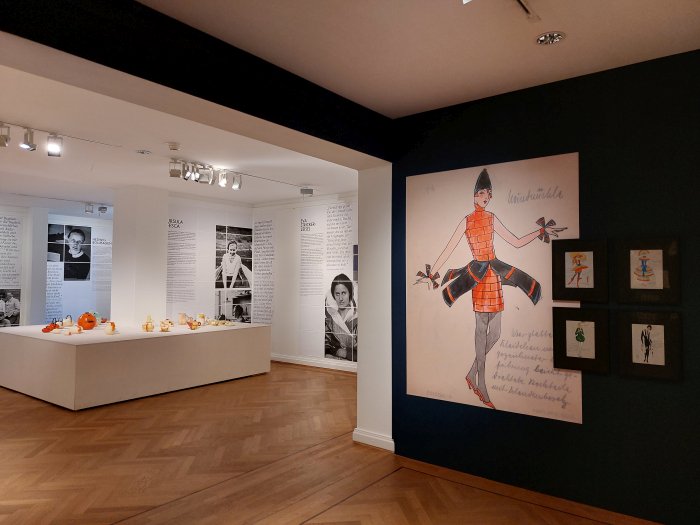
A sprightly presentation which covers a lot of ground very quickly without ever becoming rushed or losing control, which gives a voice to a great many creatives without ever drowning itself out in a unseemly cacophony, Regard! can be simply enjoyed as a very nice presentation of works created in the years 1880-1940, primarily ceramic works, an opportunity to enjoy works by creatives as varied as, for example, and amongst a great many others, Eva Stricker-Zeisel, Emmy Roth, Anna Boberg, Margarete Junge or Gertrud Kleinhempel and thereby possibly discover not only a new favourite designer or two, but a new favourite work or two.
But Regard! is much more enjoyable, and rewarding, if one steps away from the represented protagonists, or better put, if one identifies protagonists that you were unfamiliar with before, whose work interests you, and promise to yourself that you'll undertake more research at a later date, and use the protagonists as the conduits they are, uses the presentation as an opportunity to reflect on the lot of female creatives, and the whys and consequences of that lot.
An opportunity to reflect on the lot of female creatives in the early 21st century, on the situation that for all the social and cultural changes Europe has undergone since 1945, not only many of the structures, conventions and realities that influence the careers of female creatives remain, if in at times altered forms, but that the lot of many female creatives remains harder than that of most male creatives, certainly in the furniture design that is so poetically fleeting in Regard!, forming as it does a near perfect echo of the representation of female designers in contemporary furniture design, or perhaps more accurately, a near perfect echo of the visibility of females in the contemporary furniture industry9, and to question why that it is. Why that still is?
An opportunity to reflect on the lot of female creatives in the early in the early 20th century, in context of both then and now, to reflect on the fact that in their day the creatives on show in Regard! enjoyed a popular Regard!, Ansehen! the original German title can also be Esteem!, Standing!, Repute!, Eminence!, and to question why they lost that? And also to reflect on the fact that the Regard! the creatives on show in Regard! enjoyed translated into a popular Visibility!, both of which they subsequently lost, and to question why they lost that? Whys Regard! helps one appreciate aren't to do with the vain fickleness of fashion, nor an overestimation of the creatives, their works and its/their relevance in the early 20th century which has failed to survive the rigours of time; but whys primarily entwined with the nature of European society, with characteristics of European society, then and now, characteristics we all need to reflect on with a little more urgency. And whys Regard! also helps one appreciate are related to museum collections, both their composition and use: Regard! helping elucidate that as a creative of any gender, but particularly as a female, Regard! and Visibility! are hard won states, and aren't guaranteed to be maintained. And further underscores that an important component of maintaining Regard! and Visibility! is your presence in a museum collection, that your presence in a museum collection brings you a validity, places you on design's helix. Or does if a curator occasionally frees you from the isolation and anonymity of your archive shelf: as we recently opined from Wilhelm Wagenfeld A to Z at the Wilhelm Wagenfeld Haus, Bremen, an object on an archive shelf is essentially worthless in terms of what it can explain and teach.
And as an opportunity to reflect on the lot of female creatives in the early 20th and 21st centuries, to reflect on the similarities of the lot of female creatives in the early 20th and 21st centuries Regard! is also an opportunity, an invitation, an admonishment, to reflect on the lot of female creatives in the early 22nd century, because, when all is said and done, that which we do and don't do now, will determine that lot. And thus through approaching honest answers to our generations' myriad whys, we can save future generations questions of ¿why?
Regard! Art and Design by Women 1880–1940 is scheduled to run at the Bröhan Museum, Schlossstraße 1a, 14059 Berlin until Sunday September 4th
Full information, including information on opening times, ticket prices, current hygiene rules, and details of the accompanying fringe programme can be found at www.broehan-museum.de/regard-art-and-design-by-women-1880-1940/
And until Sunday August 7th the showcase Glass – Hand Formed Matter can also be enjoyed at the Bröhan Museum.
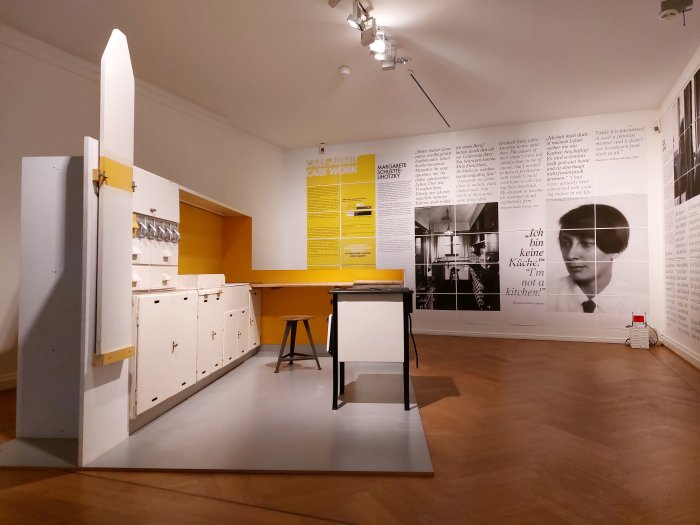
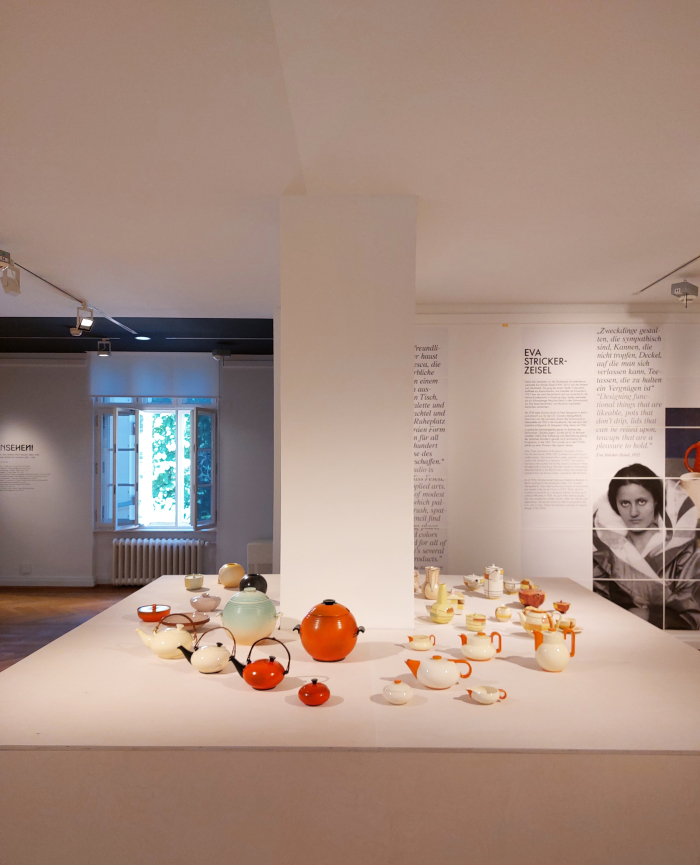
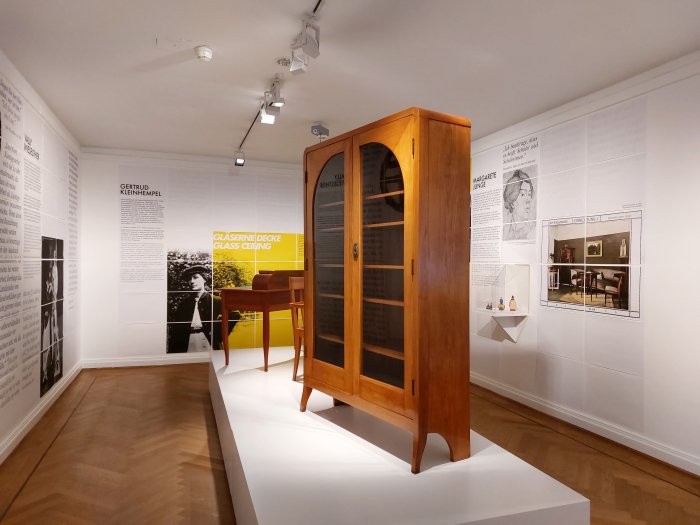
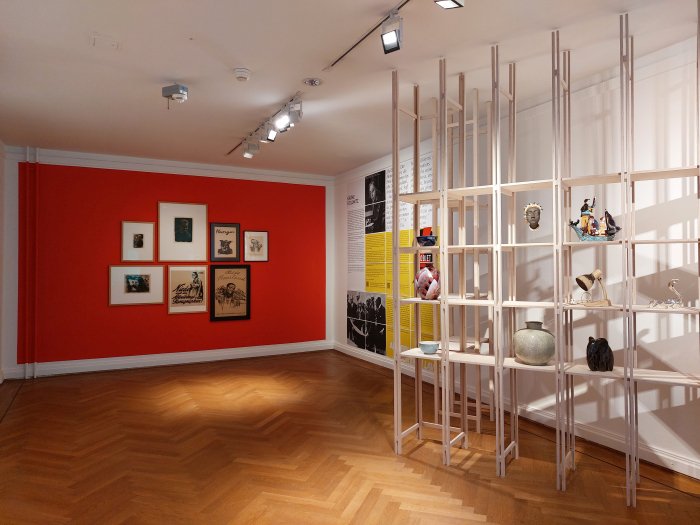
1When she designed the Frankfurt kitchen she was Margarete Lihotzky, which we consider important to remember, not least because, arguably, one of the reasons female creatives of generations past lose their visability is through changing their names following marriage: search any archive for anything on Margarete Schütte-Lihotzky before 1927 and you'll find nothing, you have to search for Margarete Lihotzky, or Frl. Lihotzky, or similar.
2Yes, we are staying very much in binary, cisgender, terms, and that not least beacuse Regard! concerns individuals who are dead, and thus, where no protestation to the contrary by the individual was ever made, we must assume that they themselves used traditional binary terms.And it ain't for us to change that. And for ease of readability we remain so when discussing the future, while crossing the bridge from the 20th to the 22nd century we stay with the terminology of the former. But clearly in 2122 the basis of the discussion will be different, may even have ceased to be an actual discussion, and the language will, invariably, be very different. But who knows where we'll end up.
3Might not be entirely true. (a) In Regard! there is no indication of when objects were added to the collection, however we can't imagine a great deal has been added since April 2019. Yes, we could ask, but our point is the principle not the specifics. See also FN 4 (b) We may have missed further female participants, apologies if we have, but again, and at the risk of sounding more like Boris Johnson than anyone ever should, our point is the principle not the specifics.
4There is no formal indication of what objects on show were collected by Karl H. Bröhan and which have been acquired since he donated his collection Berlin. Yes, again, we could ask, and may very well at a later date, but as the exhibition is of the Bröhan Museum's collection not Karl H. Bröhan's collection it is, at this juncture, of secondary importance. If very important as a guide to how design 1880-1940 as represented by Karl H. Bröhan in the 1980s compares to understanding of that period today. Where were the gaps in Karl H. Bröhan's collection?
5In fairness the catalogue highlights, for exammple, "Scandinavian Porcelain aritsts", "Decoration artists in Sèvres" and "École de Paris", see Tobias Hoffmann and Anna Grosskopf [Eds], Ansehen. Kunst und Design von Frauen 1880 - 1940, Hirmer Verlag, München, 2022
6We're not discounting the possibility that the Bröhan Museum collection as it stands is a perfect representation of design in the years 1880-1940. Would be surprised if it was, but it could well be. Such a question can only be approached by much more detailed research, is a question posed by Regard! not one that can't be answered by Regard! And one where the persuing of answers is invariably a most rewarding undertaking.
7see smow Blog Design Calendar: June 16th 1885 – Happy Birthday Lilly Reich! FN 27
8Not irrelavant to note given the Germanic focus that Karl H. Bröhan was collecting in West Germany, and thus many archive sources in East Germany, that geographic area that was such a key location of inter-War art and design, would have been essentially unaccessible. And arguably not even known.
9It will be interesting to see in context of furniture design how many manufacturers have used the Covid panademic enforced slowing of the release of new products to boost the, generally misserable, female representation in their portfolios. We're not holding our breadth, we don't expect anything will have changed, that's not how the furniture industry ticks, but in the interests of fairness, let's wait and see what develops. As a general rule it takes a couple of years for a coopeartion to devlop into a commercial product, and so it will be the middle of the decade before we can all make any sort of meaningful assessment.......